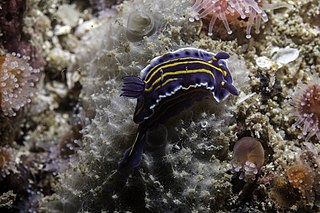
Plakinidae is a family of marine sponges. It is composed of seven genera:

Arturia is a genus of calcareous sponge in the family Clathrinidae which contains 14 species. It is named after Arthur Dendy, a prominent researcher of calcareous sponges. It was renamed Arturia in 2017 because the name Arthuria was already assigned to a genus of molluscs.

Ernstia is a genus of calcareous sponges in the family Clathrinidae. The genus was erected in 2013 to contain five species previously assigned to Clathrina. The genus name honors German naturalist Ernst Haeckel for his contributions towards sponge taxonomy and phylogeny.
Corticium diamantense is a species of sea sponge in the order Homosclerophorida, first found in vertical walls of reef caves at depths of about 23 to 28 metres in the Caribbean Sea. This species has oscula situated near its border; regular non-lophose calthrops of one size, rare tetralophose calthrops and candelabra, the fourth actine of which is basally ramified into 4 or 5 microspined rays.
Plakortis dariae is a species of sea sponge in the order Homosclerophorida, first found in vertical walls of reef caves at depths of about 23 to 28 metres in the Caribbean Sea. This species has diods of two different categories: it possesses large ones and small, rare, irregular, curved ones, which are often deformed with one of its ends being blunt ; triods are rare and regular.
Plakortis edwardsi is a species of sea sponge in the order Homosclerophorida, first found in vertical walls of reef caves at depths of about 23 to 28 metres in the Caribbean Sea. This species has diods of a single category, with thick and S-shaped centres ; triods which are T-shaped. It is the only species of this genus exhibiting small diods.
Plakortis myrae is a species of sea sponge in the order Homosclerophorida, first found in vertical walls of reef caves at depths of about 23 to 28 metres in the Caribbean Sea. This species has diods of two categories: large ones which are abundant, and rare small ones with S-shaped centres; triods which are Y- or T-shaped, and possesses abundant microrhabds.
Plakina nathaliae is a species of sea sponge in the order Homosclerophorida, first found in vertical walls of reef caves at depths of about 23 to 28 metres in the Caribbean Sea. It has a leaf-like flat body, which is loosely attached to the substrate and a perforated, unlobate surface; it contains two bacterial morphotypes and is characterized by two mesohylar cell types with inclusions.

Felimare lajensis is a species of sea slug or dorid nudibranch, a marine gastropod mollusc in the family Chromodorididae.
Oscarellidae is a family of marine sponges.

Plakortis is a genus of marine sponges in the order Homosclerophorida, first described by Franz Eilhard Schulze in 1880.
Plakortis bergquistae is a species of marine sponge in the order Homosclerophorida, first described in 2011 by Guilherme Muricy. The species epithet, bergquistae, honours Patricia Bergquist.
Plakortis communis is a species of marine sponge in the order Homosclerophorida, first described in 2011 by Guilherme Muricy.
Guilherme Muricy is a Brazilian invertebrate zoologist, and Professor of Invertebrate Zoology at the National Museum of Brazil. He is a specialist in sponges and has written over 100 papers on the chemistry, the taxonomy of sponges, and the descriptions of many new sponge species.
Plakortis hooperi is a species of marine sponge in the order Homosclerophorida, first described in 2011 by Guilherme Muricy. The species epithet, hooperi, honours John Hooper, an Australian sponge specialist.
Plakortis insularis is a species of marine sponge in the order Homosclerophorida, first described in 2003 by Moraes and Guilherme Muricy, from specimens collected from oceanic islands off north-eastern Brazil.
Plakortis microrhabdifera is a species of marine sponge in the order Homosclerophorida, first described in 2003 by Moraes and Guilherme Muricy, from specimens collected from oceanic islands off north-eastern Brazil.
Corticium is a genus of sponges in the order Homosclerophorida. first described by Eduard Oscar Schmidt in 1862.
Corticium furcatum is a species of sponge in the order Homosclerophorida. It was first described in 2021, from a fragmented specimen collected at a depth of 5-7 m on the Booker Rocks in Jurien Bay.




